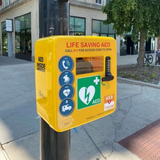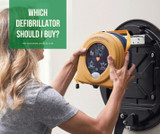AEDs in Construction
There are of course risks that come with working in the construction industry meaning health and safety must always be reviewed in order to be improved to keep the working environment as safe as possible at all times. However, with this, regardless of all health and safety procedures, it is often impossible to tell when someone may fall ill due to a sudden cardiac arrest (SCA).
They are often unpredictable and when they occur, you need to act fast. A SCA is caused due to the electrical rhythm in the heart being faulty, causing the heart to stop beating at it’s usual pace. Due to this, a victim will quickly fall unconscious and their breathing will stop or be irregular. When this happens, you must immediately call 999 and begin CPR.
Once CPR has begun, using an automatic external defibrillator (AED) is the next step. AEDs work by shocking the heart in order to stop it, in hope that it will return it back to it’s natural rhythm and although survival rates are relatively low from someone who is suffering a SCA, AEDs can increase this survival rate by over 70% if used in the first three to five minutes.
Putting themselves under more physical strain than most other jobs, workers in the construction industry carry out a labourous job five days a week meaning the strain on their body is increased. Although a SCA can occur to anyone regardless of age, gender, weight and apparent health, working a physical job puts someone under more physical strain when comparing them to someone working in an office.
If someone did suffer from a SCA whilst at work, there is also a risk that it would take longer for the emergency services to arrive as getting on to a construction site and factoring in the amount of space available could slow the process down.
Having an AED on every construction site would mean that life saving care can be delivered, saving precious seconds whilst waiting for the emergency services to arrive. With AEDs being designed for use by anyone, you do not need to be trained to save a life.
Most AEDs come with verbal instructions that guide the user through the process, with visual guides and lights which also indicate which step must be followed next. It important to note that with a defibrillator, it will never deliver a shock unless one is needed. AEDs cleverly trace the heart and detect whether it is in need of a shock and with an automatic defibrillator, will do this itself.
In the UK, there are over 30,000 SCAs occurring outside of hospitals every year. SCA’s can occur at anytime meaning someone may be at work, at the shops or just passing by when they fall ill and without immediate help, 90-95% of SCA’s prove fatal. This means that having an AED in your working environment when you work in the construction industry can make the difference between life and death.
It wouldn’t be acceptable to enter a construction site without wearing a hard hat, the correct safety boots or a high visibility vest and it should be the same for an AED. Although a SCA doesn’t pose as an immediate threat to safety, if anyone should suffer one whilst at work, a defibrillator could save a colleagues life.
There are a variety of AEDs on the market that are designed for outdoor use. Manufactured from robust materials making them strong, durable and able to withstand being dropped, some AEDs can be stored outside and are resistant to adverse weather conditions making them ideal for a construction site.
AEDs really can make the difference between a life lost and a life saved. Although the chance of one happening is slim, it should still never be overlooked. Having one at your place of work provides peace of mind in knowing that should you ever need such emergency care, you have it at your fingers.
Recent Posts
-
Empowering Communities: The Lifesaving Impact of CPR on Restart a Heart Day
Every year, on and around October 16th, an important event takes place - Restart a Heart Day. This a …16th Oct 2023 -
Which home defibrillator?
80% of all out of hospital cardiac arrests occur at home. Defibrillators are often available in loca …4th Dec 2022 -
Which defibrillator should I buy?
There are many defibrillators available on the market and it can become overwhelming knowing which o …4th Nov 2022




